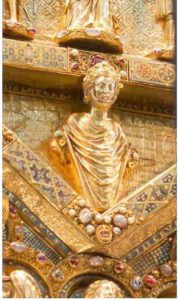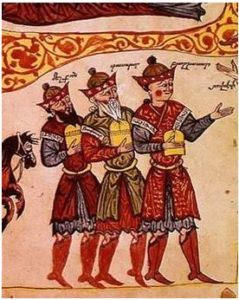The three magi, the three Kings of the East, or the three wise men (Latin magus, a wise man, Greek μάγος), are also known as the three Kings of Cologne, their bodies having supposedly been deposited in Cologne Cathedral in 1164 by Rainald of Dassel, who looted them from Milan after the Holy Roman Emperor Frederick Barbarossa’s second siege of that city in 1162.


Melchior’s name is from the Hebrew, malki-or, “my King of light”. Caspar’s name (also found as Gaspar or Jasper) is Persian, from Kansbar, a treasurer. Balthazar’s name is Babylonian, from Baal-tas-assar, “may Baal preserve his life”, related to Belshazzar, whose feast is described in the Book of Daniel, from Bel-shar-uzzur, “May Bel protect the King”. The Babylonian god Bel, mentioned in Isaiah and Jeremiah, was cognate with Baal, a fertility god of the Northern Semites, who is mentioned several times in the Old Testament. He was also Marduk, the Babylonian god of the spring sun, and Belus, a Phoenician god; En-lil, the Babylonian god of the earth was also often referred to as Bel. In Hebrew “baal” came to mean a lord; the name Beelzebub means “Lord of the Flies”.
The magi, wise though they were, may not have been physicians, but their gifts of gold, frankincense, and myrrh, described in Matthew (2:11), have been used in modern therapeutics.
The IndoEuropean root GHEL, to shine, gives us words such as yellow and gold, among many others. Another IndoEuropean root AUS, to shine, like the dawn aurora, gives aurum, Latin for gold. Gold salts, sodium aurothiomalate, given intramuscularly, and auranofin, given orally, have been used to treat rheumatoid arthritis. Taken up by macrophages, they inhibit phagocytosis and lysosomal enzyme activity and suppress cell mediated immune reactions; in rheumatoid arthritis they reduce the concentrations of rheumatoid factor and immunoglobulins. Their therapeutic effects develop slowly, reaching a maximum after 4–6 months. Up to 50% of patients respond. Adverse reactions are common and can be serious. They include proteinuria and nephrotic syndrome, rashes, including exfoliative dermatitis, thrombocytopenia, neutropenia, and pancytopenia; oral gold commonly causes diarrhoea.
Frankincense comes from Old French, franc encens. The mediaeval Latin ethnic name Francus came to mean “free”, because in Frankish Gaul only those who belonged to the dominant group, or were adopted into it, were completely free. Here it means “of high quality”. Encens was from the Latin ecclesiastical word incensum, incense, from incendere, to set alight. The IndoEuropean root is KAND, to shine, which gives us candle and candelabrum, candour, candid, and candidate, incandescent, incendiary, incense, and censer.
Frankincense is a mixture of gums and spices, which produces a sweet smell when burned. Medically it typically refers to the gum resin of Boswellia serrata, in Greek λίβᾶνος, long used as a traditional remedy in Ayurvedic medicine for inflammatory diseases. The gum contains pentacyclic triterpenes related to boswellic acid, which inhibit leukotriene biosynthesis in neutrophil granulocytes by inhibiting 5-lipoxygenase. It also contains monoterpenes, diterpenes, ethyl acetate, octyl acetate, and methylanisole. Certain boswellic acids inhibit leukocyte elastase, proliferation, and topoisomerases in cancer cell lines, and induce apoptosis. Frankincense has been claimed to have anti-inflammatory effects in ulcerative colitis, irritable bowel syndrome, bronchitis, sinusitis, and asthma, and an antiproliferative effect on tumours.
Myrrh comes from the Semitic root MRR, to be or become bitter, giving the Greek words μύρον, an unguent or perfume, and μύρρα, myrrh, with variants σμύρνα and ζμύρνα, like the name Smyrna, the Turkish port now called İzmir. In Hebrew מר, mar, means bitter, like מרור, maror, the bitter herbs eaten at Passover. Myrrh is an aromatic gum resin exuded by various Arabian and African trees of the genus Commiphora (family Burseraceae), originally used as an astringent and expectorant. Commiphora molmol has reportedly in vitro antihelminthic and cytotoxic actions and has been used to treat fascioliasis and schistosomiasis. Adverse reactions include giddiness, somnolence, and mild fatigue.
Melchior gave gold, an emblem of royalty, Caspar gave frankincense, an emblem of divinity, and Balthazar’s myrrh prophesied death. They could hardly have predicted their modern uses. Gold salts are effective. About frankincense and myrrh I make no claims whatsoever.
 Jeffrey Aronson is a clinical pharmacologist, working in the Centre for Evidence Based Medicine in Oxford’s Nuffield Department of Primary Care Health Sciences. He is also president emeritus of the British Pharmacological Society.
Jeffrey Aronson is a clinical pharmacologist, working in the Centre for Evidence Based Medicine in Oxford’s Nuffield Department of Primary Care Health Sciences. He is also president emeritus of the British Pharmacological Society.
Competing interests: None declared.
